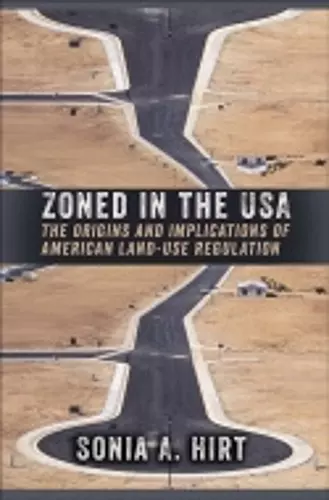Zoned in the USA
The Origins and Implications of American Land-Use Regulation
Format:Hardback
Publisher:Cornell University Press
Published:4th Dec '14
Currently unavailable, and unfortunately no date known when it will be back
This hardback is available in another edition too:
- Paperback£23.99(9780801479878)

Why are American cities, suburbs, and towns so distinct? Compared to European cities, those in the United States are characterized by lower densities and greater distances; neat, geometric layouts; an abundance of green space; a greater level of social segregation reflected in space; and—perhaps most noticeably—a greater share of individual, single-family detached housing. In Zoned in the USA, Sonia A. Hirt argues that zoning laws are among the important but understudied reasons for the cross-continental differences.Hirt shows that rather than being imported from Europe, U.S. municipal zoning law was in fact an institution that quickly developed its own, distinctly American profile. A distinct spatial culture of individualism—founded on an ideal of separate, single-family residences apart from the dirt and turmoil of industrial and agricultural production—has driven much of municipal regulation, defined land-use, and, ultimately, shaped American life. Hirt explores municipal zoning from a comparative and international perspective, drawing on archival resources and contemporary land-use laws from England, Germany, France, Australia, Russia, Canada, and Japan to challenge assumptions about American cities and the laws that guide them.
[Hirt] provides a succinct overview of the history of zoning in the US. She compares zoning in the US to five European countries—England, France, Sweden, Germany, and Russia—to highlight its distinctiveness. The story of American zoning reveals its origins in the early-20th century, fashioned to maintain property values and protect Americans' investments in their homes. The book tells the story of how local, state, and federal governments have contributed to the use of zoning to preserve the single-family detached home, connecting zoning to other policies, such as transportation and home loan financing. This is a terrific book for collections on housing, land use, zoning, and law.
* CHOICE *Hirt has given us a thorough history of what we have been doing and a fine description of what we can learn from other countries. Nicely illustrative tables/figures and 'textboxes' make it well suitable for upper-division and graduate students.
-- Ulf Zimmermann * Planning Perspectives *This is an excellent book and an impeccable introduction to American zoning for anyone interested in US city planning and urban geography. In one sense, it is a primer on US zoning theory and practice: it provides all the basic elements and history in a mercifully succinct manner in under two hundred pages. This would bean ideal book to give to a student or colleague just cutting hisorher teeth in urban studies. Yet, at the same time, Sonia Hirt makes some original contributions to the field by clearly placing American practices in international and historical perspective. The book worked for me on both levels. I have been reading US books on urban history and geography for nearly fifty years, starting with postwar studies of zoning by the likes of John Delaphons, Stephen Toll, and Richard Babcock, and histories of planning and urban development by such authorities as Peter Hall, Mel Scott, and Sam Bass Warner; I even reached back to the pioneers of American urban studies like Robert Hurd, Herbert Swan, and Louis Mumford. It was a pleasure to encounter them again here and be reminded of the twists and turns of citymaking in the United States. It was even more of a delight to be shown that history with such remarkable clarity and in a new light.
-- Richard Walker * H-Environment *This kind of comparative research deserves more support and encouragement. Although it is difficult to do, it holds out the promise of a richer analysis of the historical development of institutions—particularly, as in this case, when cross-national policy transfer is an explicit part of the history.
-- Jerome Hodos * Journal of American History *Why can a German get his taxes done by walking downstairs while I, in a perfectly dense neighborhood in Los Angeles, need to get in my car to find a konditorei? This is, essentially, the question Sonja Hirt asks in Zoned in the USA, a surprisingly rousing analysis and history of American zoning laws. It takes an outsider like Hirt—who is Bulgarian and therefore familiar with both European cities and governmental power—to recognize the stark differences between the control of land in American cities and that in their counterparts elsewhere in the developed world. A professor of planning at Virginia Tech, Hirt positions herself as the Alexis de Toqueville of planning, equally baffled and fascinated by the odd world that Americans have built.
-- Josh Stephens * Planetiz- Winner of Winner, John Friedmann Book Award (ACSP); Choice M.
ISBN: 9780801453052
Dimensions: 235mm x 155mm x 25mm
Weight: 907g
256 pages